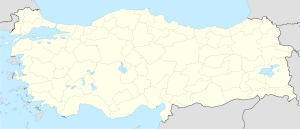- Maşat Höyük
-
Coordinates: 40°8′54″N 35°45′44″E / 40.14833°N 35.76222°E Maşat Höyük[1] is a Bronze Age Hittite archaeological site 100 km nearly east of Boğazkale/Hattusa, about 20 km south of Zile, Tokat Province, north-central Turkey. The site is under agricultural use and is plowed. It was first excavated in the 1970s.
Masat Höyük Location in Turkey Coordinates: 40°08′54″N 35°45′44″E / 40.14833°N 35.76222°E Contents
History
The enigmatic marauding Kaskas burned this site during Tudhaliya's reign. The Hittites rebuilt it under the next king Suppiluliuma I.
Cuneiform tablets from the site form a new archive of Hittite texts. The letters found at Masat Höyük were edited by Sedat Alp in a two-volume edition in Turkish and German in 1991. Most tablets here are correspondence between the site and the Hittite king, a "Tudhaliya" who was probably Tudhaliya III; most concern the Kaska front. The Hittites' capital at this time was either Sapinuwa (which has been found) or else Samuha (which has not). One place-name mentioned in the texts is Tabigga/Tabikka, which is now generally considered to be the Hittite name of the Maşat Höyük site.[2]
The site also contains 14th-century Helladic_period[3] ware from mainland Greece.
Archaeology
Wood collected by field archaeologist Tahsin Özgüç of Ankara University at the upper Hittite level at Masat Höyük has been added to the Aegean Dendrochronology Project, a 30 year-long project established to build tree-ring chronologies for the Eastern half of the Mediterranean. The wood, which was tentatively dated to 1353 BCE, was retrieved from an excavation site of a building where archeologists also had found imported Late Helladic IIIA/B Stirrup jars, a famous form of pottery.[4] In 2005, the project published an updated report on the dendrochronology research results for Anatolia.[5][6]
Notes
- ^ Höyük means mound.
- ^ As by Trevor Bryce, The Kingdom of the Hittites, rev. ed. 2005.
- ^ The ware at the site is correlated to Late Helladic IIIA (LHIIIA:1).
- ^ Aegean Dendrochronology Project December 1996 Progress Report. Retrieved 20 May 2008.
- ^ Kuniholm P.I., Newton M.W., Griggs C.B., Sullivan P.J. (2005). "Dendrochronological dating in Anatolia: the second millennium BC". Der Anschnitt 18: 41–47.
- ^ Data from the Aegean Dendrochronology Project is available at the International Tree-Ring Data Bank (ITRDB) at NOAA. See also Gordion Tree-ring measurements.
References
- Alp, Sedat, 1991. Maşat Höyük'te Bulunan Çivi Yazılı Hitit Tabletleri, Hethitische Keilschrifttafeln aus Maşat-Höyük (Cuneiform Tablets Found in Maşat-Höyük, (series Türk Tarih Kurumu Yayinlari, VI. vol. 34)
- ---, 1991. Hethitische Briefe Aus Masat-Hoyuk(series Türk Tarih Kurumu Yayinlari, VI. vol. 35)
- Özgüç, T. 1978. Masat Höyük Kazilarive Çevresindeki Arastirmlar: Excavations at Masat Höyük and Investigations in its Vicinity, Ankara (TTK Yayinlari, V Dizi - Sa. 38). Turkish/English text
- Yakar, Jak, "Excavations at Masat Hoyuk and Investigations in Its Vicinity" Journal of the American Oriental Society 100/2, pp 175-177.
- T. Özgüc, Masat Höyük, 11, A Hittite Center Northeast of Bogazköy, ser. V. no. 38a, Türk Tarih Kurumu Yayinlari, 1982
See also
External links
Categories:- Tokat
- Hittite sites in Turkey
- Archaeological sites in Turkey
Wikimedia Foundation. 2010.

